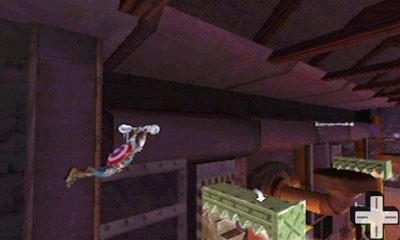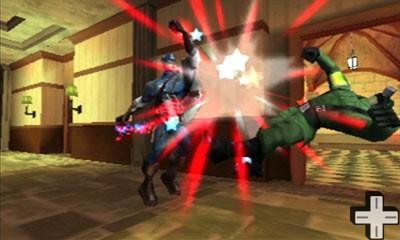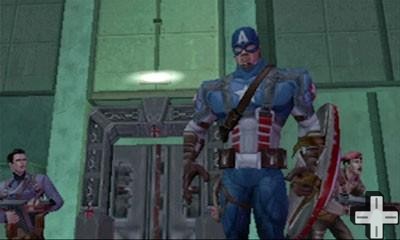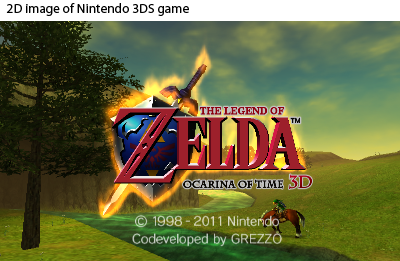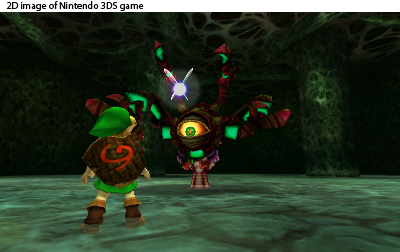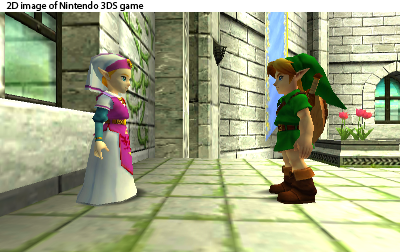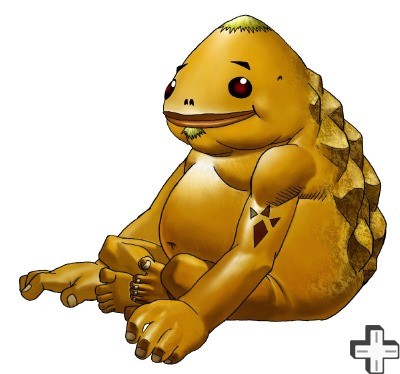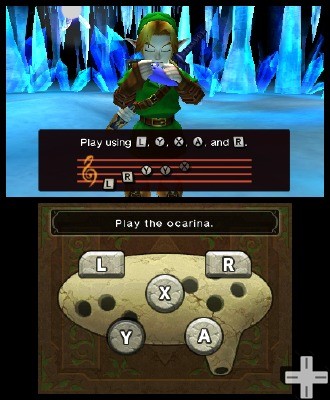Resident Evil Revelations

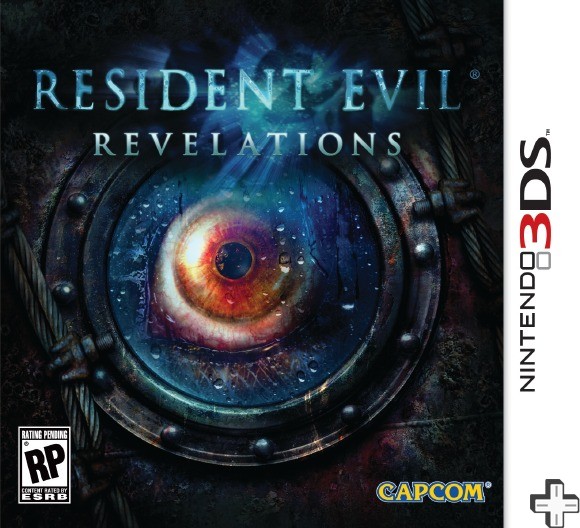
Resident Evil has come along way since its humble beginnings as a PlayStation 1 title. In the last 16 years, there have been 6 full games, with a seventh due by the end of the year, and more spin offs and movie deals that a zombie with all of his rotting digits can count. It can also be argued that the franchise has moved away from the Survival Horror genre it created into the territory of Action/Horror. The latest instalment – Resident Evil Revelations however has different ideas.
From the outset, the game looks and feels like the latest instalment into the series. It has the same over the shoulder look as Resident Evil 4 and 5 and even the character models are similar, although Chris has lost a lot of his bulk since the last time we saw him. The game spends the majority of time in an abandoned cruise ship where Jill Valentine and Parker Luciani are sent to find Chris.
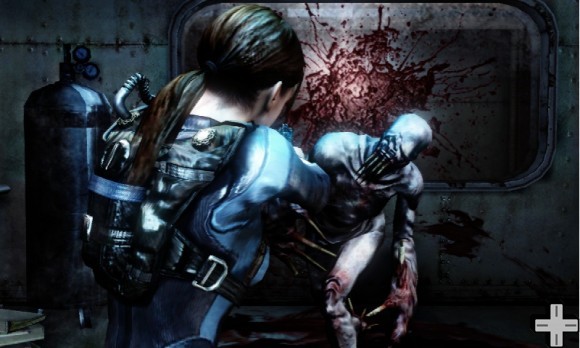
Of course, all is not what it seems and the way the story unfolds is more an old school approach than we have seen in recent times. The cruise liner can quite easily be compared to the mansion from the first game or even the train scenario from Resident Evil 0 as the vessel is lined with unthinkable monsters and has to be navigated in a slow and calm manner and presents an air of claustrophobia.
Resident Evil Revelations brings an element of terror and suspense to the 3DS in a way that has not been seen since the PlayStation days. Enemies will crop up anywhere at anytime and as Capcom have opted to use BOWs instead of Zombies, they can drop, slide or burst through pretty much anything to suck your face off.
The game is set out in episodes (and you are even given a cheesy American TV “previously on Resident Evil Revelations” recap when returning to the game), which cause breaks in the mood in favour for a more action-based approach. This does fragment the game’s story in terms of flow but it does piece together the story in a way that means it wasn’t necessary to have played Resident Evil 5. What the change in pace provides for the game is a chance to show off its control system.
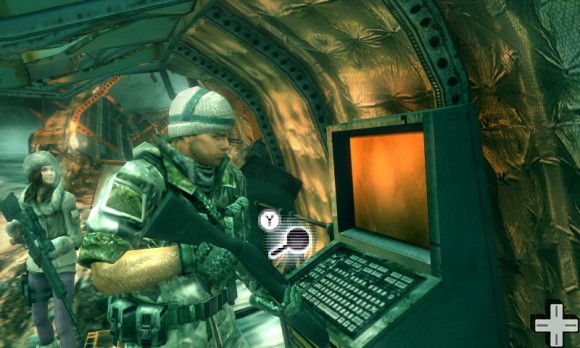
This is where Resident Evil Revelations has no shortage, as there is an almost infinite amount of controls to be implemented. Most are a mix of button and stylus configurations, with the choice of a first or third person aiming perspective. As the aim requires the character to stand still and with a useless AI partner just like Resident Evil 5, this results in a lot of deaths. Thankfully, Capcom have decided to use the Circle Pad Pro accessory and using two sticks instead of one makes the game a whole lot more manageable and highly recommended as the way to play the game.
A well as the Circle Pad Pro, Capcom have incorporated a multiplayer element to Revelations, which allows two players to cooperatively navigate the levels in order to obtain points to spend on weapons. Known, as Raid Mode, the mission is to get from one end of the level to the other. These are tweaked versions of the main game so different enemies will attempt to halt progress where ever possible. Street Pass is also included to send health and ammo to one and other.
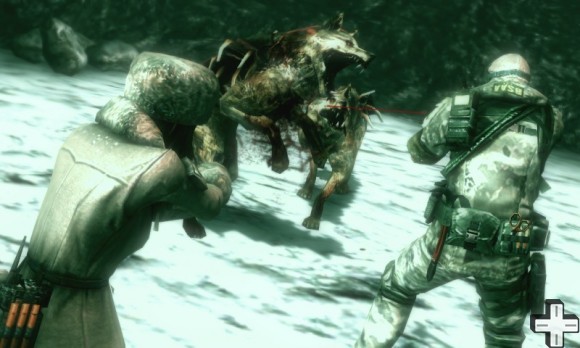
Ammo and health from strangers will be greatly appreciated because Revelations isn’t just a game of Resident Evil titles past in terms of story, Capcom have stripped down the Herbs and ammunition to a minimum. What they have saved on ammo however, Revelations makes up for on looks. Visually it is stunning. It pushes the Nintendo 3DS console to another level and there isn’t anything on the system that compares. The 3D is wonderfully implemented so you can judge the distance between an enemy to work out if it is better to run or fight.
The only issue with the 3D is when you notice how far Chris or Jill’s buttocks stick out of the screen, it is hard to take your eyes off them. Another point to rise is the inclusion of a Genesis Scanner. This encourages you to scan any BOW or point of interest that is in the area in return for health items. Since you have to do this during action sequences, the health earned is massively disadvantaged to the health lost.
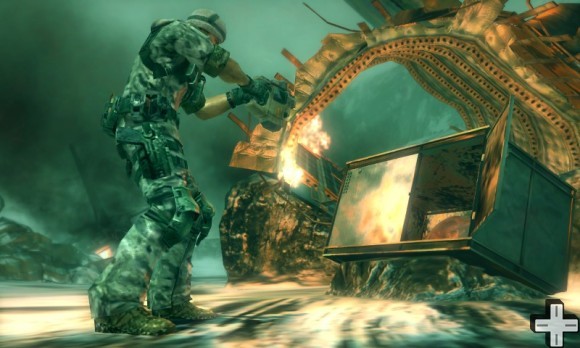
It seems for every old survival horror point in Resident Evil Revelations there seems to be a deliberate point to counteract this. For Revelations, this unfortunately comes across as muddled. If Capcom took out the utterly diabolical AI that is as useless as a cow on the moon and dialled down the action sequences this would have been the best Resident Evil game since number two. At its heart beats the survival horror game it deserves to be and ticks all the right boxes, great graphics, great story, great controls (with the Circle Pad Pro) and very little ammo to be moving on with.
Be in no doubt that Revelations will have you throwing the Nintendo 3DS across the bed in terror as it is pant wettingly scary. The core of Resident Evil Revelations proves that Capcom can still make the perfect Survival Horror game 16 years after they created the genre. Everything around this proves Capcom just don’t want to.
Mario Kart 7

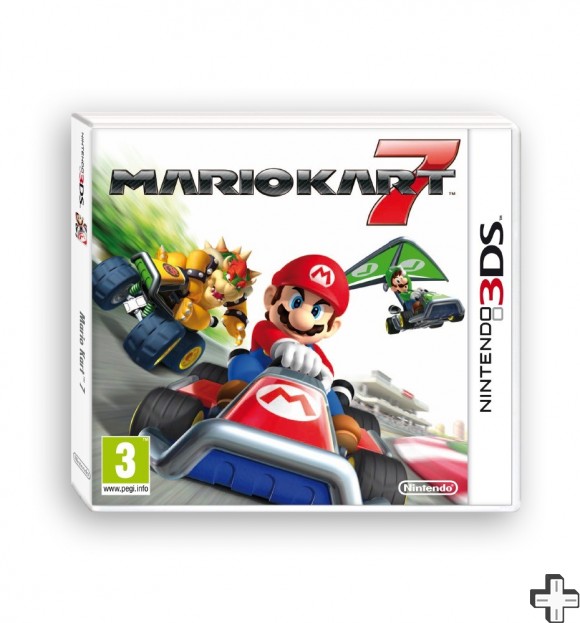
One thing is certain with Mario Kart in that each version is different from the last. Mario Kart 7 comes to the Nintendo 3DS with the same familiarity as previous editions, however may as well throw the number 7 to the roadside as this is so far removed from anything Nintendo have produced in the series so far.
The standard characters: Mario, Bowser, Peach etc are together as they should be. The classes remain the same and heck, there are still 32 tracks split into 8 cups to race around. 4 of these cups hold 16 new race courses whereas the remaining cups hark back to previous instalments. This may all seem correct, but this is where Mario Kart 7 stops being a standard karting game and defines itself as the best in the series.
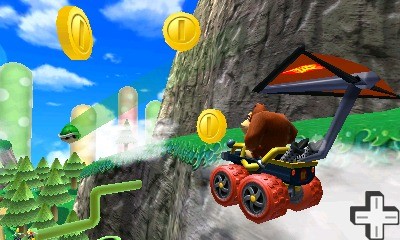
Quite a claim this maybe, however Nintendo have a knack with this particular franchise of filtering out the good points to a game and removing the negative to apply to the next game along. Mario Kart 7 does exactly that. The most noticeable factor is the AI. Gone are the days where Bowser can sneak up on the last lap and bombard you with Red, Green and Blue shells dropping you from first to dead last. Now, this is a more controlled and calculated battle from the word go. In the single player mode, the AI act as humans, cutting corners, aiming their green shells and timing their squids to cause the maximum disruption.
What this means is players have to fight for 1st rather than build up a great lead over two laps only to get destroyed on the last. There are less easy victories and more cursing that with half a lap to go, a blue shell assassinates you. To help fight back, Nintendo have kindly added some weapons to the course. The regulars are there as normal as well as a few new ones to spice things up. The Tanooki tail continues its resurgence to the Mario world as it can be used to swipe cars out of the way with minimal effort.
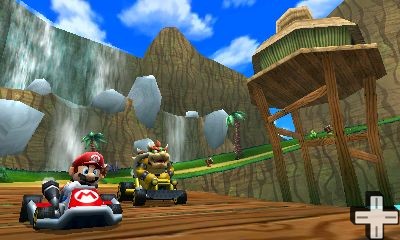
If you are dead last, which may be a possibility for some, Nintendo don’t just throw in a pointless blue shell or lightning bolt anymore, oh no. You may find yourself hitting a lucky 7 power up. This gives the driver, you guessed it, SEVEN powerups to get back into the thick of the action. They encircle the kart and you feel like a kid in a candy shop deciding which item is going up Yoshi’s tail pipe. Mario Kart 7 isn’t all about the weapons though, the courses are awash with coins, which haven’t been seen for a long time. These give you a little boost when they have been collected but more importantly help out for another reason. Customisation.
In another major change for the series, karts can now be customised to give a more unique riding experience. Previous installments only had light weighted, middle and heavy weight characters. Now, Bowser’s weight can be offset against a smaller car. This custom karting is limited to 4 factors: Racers, Chassis, Wheels & Gliders, so it keeps things simple unlike other racing games where it goes into brake pads and wheel nuts or if you wanted flame decals for whatever reason. Gliders, also a new addition, are used in some races to, well, glide a player from a high area to low and avoid any pitfalls or obstacles below.
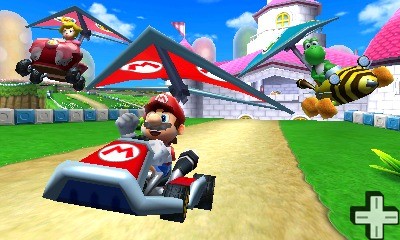
While flying, racing under water or just rallying the kart around a track at speed, it cannot escape the attention that each course is memerable and different to the last. Each course has been beautifully crafted in such away that they are challenging to drive but enjoyable at the same time. Nintendo haven’t stopped at just a wonderfully crafted set of race courses, the dynamics of the race for some have changed. Some of the races now only have one lap. This keeps the game fresh (or if you are American – dope) as it is harder to learn the twists and turns thrown at you.
As with all Mario Kart games, Mario Kart 7 is designed for multiplayer and unlike changing the dynamics of the single player, Nintendo thought it would be best to stick to its roots.Ultimately the multiplayer remains unchanged from the Wii version. There is a choice of Grand Prix or battle modes, which can be played either on or offline. Online play has been made simpler because of the single friend code required to play against friends, it also seems to find people and join races quicker than Mario Kart Wii. Offline, there is a choice of modes dependent on how many game packs are used. If there is only one game between four then the tracks are limited.
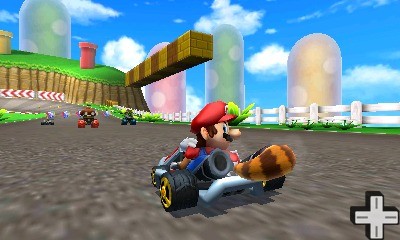
Streetpass makes an appearance in Mario Kart 7 and this allows players to exchange racer information and Ghost data. This information can be used to battle online if each player so wishes, this does utilise the Nintendo 3DS and brings the Mario Kart community closer than it has ever been. The only issue with this is that the friend code system is a cumbersome beast and does rather unnecessarily interrupt online play.
This being said, Mario Kart 7 ticks all of the other boxes one would expect with a racing game. The welcome additions such as customisation and the mix up with the track styles all provide a challenging and more importantly fun entry to the series. The use of the 3DS’s unique features build to the experience of the game in particular the 3D effect means you can get a feel of the race and how much work you have to put in to take the lead. Nintendo’s archaic approach to online gaming does hinder the title a little but it is a vast improvement to what we have seen on the Wii. The first person control system is also a dud point as it requires the gyro sensors to move, and much like the previous game, Mario Kart 7 works best as a joypad experience.
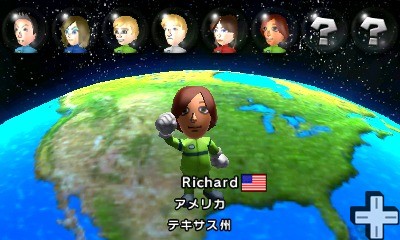
Mario Kart 7 is without a doubt the best and most enjoyable entry for the series. It is simple, and yet challenging, it is easy to get into but has a great depth to it. It takes all the plus points from past experiences and adds its own flair to the mix. It is worth a purchase for anyone who owns a 3DS. Even if you do not like racing games. Yes, it is just that good!
Crush3D

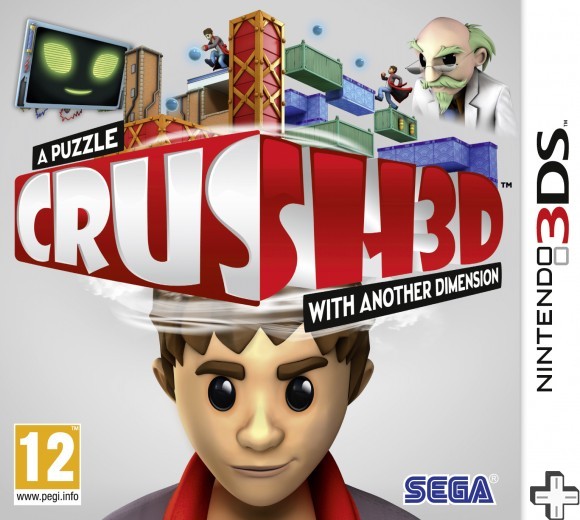
Dr Jekyll and Mr Hyde, Frankenstein and his monster, Seymour Krelborn and Audrey II even Marty and the Doc all have one thing in common, one is a normal, down to earth individual and the other is totally insane. It’s the perfect mis-match between characters that just works when thrown into the melting pot together. The same thing can be said about Danny and Dr Reuben. One is the typical teenage insomniac with the strange obsession with dressing gowns and the other is the mad scientist who is trying to help Danny sleep with his C.R.U.S.H machine.
Cleverly standing for Cognitive Regression Utilizing pSychiatric Heuristics and avoiding the issue of a real scientific word beginning with S, Dr. Reuben sends Danny into his own mind albeit a tad reluctant as he is referred to as a guinea pig, to address the reasons why he cannot sleep. This is where Crush3D starts. Created by Zoe Mode, the team behind Chime, the idea of the game is simple, to collect Danny’s marbles to open a path to progress through some 50 levels.
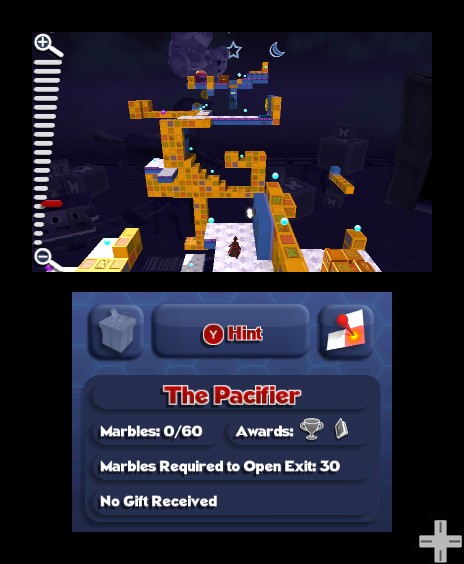
To do this, Danny must alternative between two and three dimensions to create paths and collect all the marbles required. Luckily, not every single marble is required to progress, but the more that is gathered the better. Adorning the levels are various trophies and special items that unlock various artworks and gowns, yes Danny’s addiction to dressing gowns reaches the realms even Arthur Dent will be proud of, as there are just shy of 100 to collect!
Making things difficult, the level can be crushed in just about any direction, provided Danny isn’t squashed in the process. This adds an extra level of difficulty and longevity to Crush3D as it is requires a lot of thought to each move or it could well mean a restart. Especially if chasing a perfect level. Luckily the camera is easy to control and there is no time limit on a level so taking your time is perfectly acceptable.
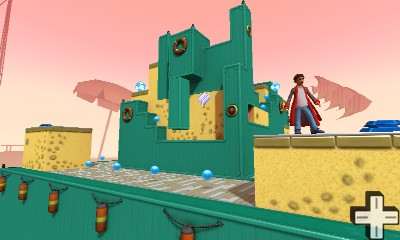
If this isn’t enough difficulty for one game, if a trophy is collected through out the level a harder version of the same stage unlocked. It’s harder in the fact the level is against the clock, with a limited number of crushes. It certainly cannot be said the game doesn’t push the limits of any seasoned puzzle gamer.
Luckily controlling Danny is as simple as peas: he can run, jump and push objects to his hearts content. He isn’t the best at jumping mind, which can be a little frustrating at times as the last marble can just be out of reach, prompting anger and the odd rage quit here and there. There are hints to be used, but these effect the items that can be unlocked and takes away that perfect score many people crave while playing.
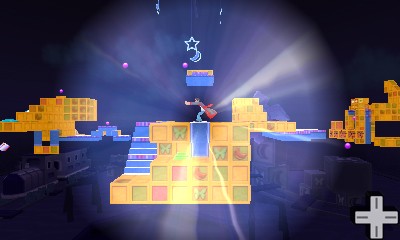
Crush3D is actually a reworking of the PlayStation Portable title Crush from 2007, and as a comparison the Nintendo 3DS incarnation is a better looking and more friendly compared to the moody, dark and dim presentation on the PSP. It also integrates the StreetPass feature of the Nintendo handheld with users able to gift items to each other to be placed randomly throughout the 50 levels.
Once the levels are beaten, there is little to replay save for the hard mode versions of effectively the same stage. A level editor of sorts would have been a nice addition and could have made more use of the StreetPass function. If the game does get a sequel, a strong plea for a level editor and downloadable content would be fantastic additions and would expand the experience.
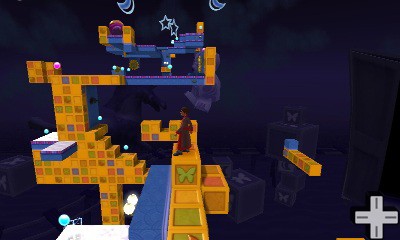
The game isn’t for anyone who suffers from rage quitting-itis and can become a little bit on the strenuous side even for the most patient of gamers. But sticking with it, you are rewarded with more extras and even more challenging levels. Visually, Crush3D is a very good lucking game and makes use of the 3D element of the 3DS very well. Danny & Dr. R work well as a team and there is a great sense of achievement unlocking another dressing gown. If you have managed to play the PSP version there isn’t much between that and the new version save for the visuals – which do work better on the 3DS. If you have never played the original and fancy a challenging puzzle game however, SEGA and Zoe Mode delivered this big time.
Shinobi

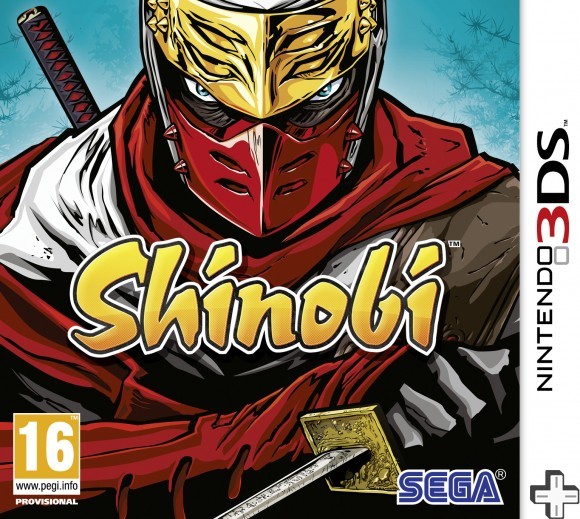
Since the dawn of time there have always been ninjas, well near enough. Those pesky assassins can never be seen so we don’t really know when they started creeping around dark alleyways at night. Even so, SEGA since the mid 1980s had started documenting the exploits of one such ninja. Or Shinobi as they were known in the west at the time as the N word was considered to offensive an sinister to use over in this part of the world. That has now been relaxed but the Shinobi name still remains for this series. That is because save for a minor reboot on the PlayStation 2 between 2002-2003 the games have stayed in the mid eighties – mid nineties.
Fast forward almost a decade and here we have the 2011 game with the simple and yet effective title – Shinobi. Released for the Nintendo 3DS, this is a statement by SEGA that a return to roots type of game can appear on the latest and most up to date console at the time. It is a return that many have craved since the 3D incarnation since the PlayStation 2 games were actually half decent.
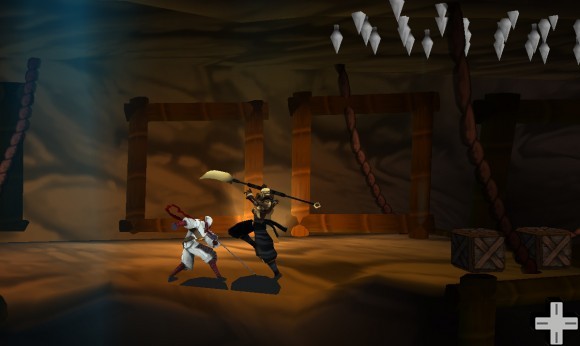
From the get go, this isn’t just a rehashing of a PS2 game released 9 years previously. Shinobi is a new story and bringing the series back to it’s roots – a rock solid two dimensional side scroller. Set before the original, the main protagonist is Jiro Musashi – the father to our hero from previous games and now we know where Joe got his skills from. Starting in Feudal Japan, it is up to Jiro to fight a deadly clan and find the “friend” who betrayed him. To do this Jiro has the same katana and shuriken weapons which have been ever present though out the series, and even a handy parry button has been included. There is also Jitsu magic, which can be used to become more powerful or effect the stage in play, but in reality it is hardly ever used.
If magic is used, it takes away from the total score at the end of each level and to gain the top ranks, playing it safe is the key as everything, yes everything has points attached to it. Sword attacks earn more than long range weapons, and getting hit subtracts. In true arcade style, the more points the better.
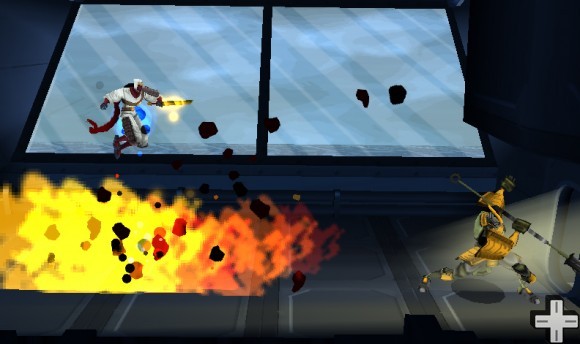
Also in true arcade fashion, moving from left to right defeating ninja after ninja is the aim of the game. This may sound like a chore but it is surprisingly difficult even on the lower difficulty settings. If timing is off or a button isn’t pressed quickly enough then it’s game over. This means to play Shinobi, one must become a Shinobi. Or at least have the reflexes like one. The controls respond beautifully to quick and successive pushes so when dying multiple times, it can be safe to assume it’s not the game’s fault.
Progressing in Shinobi, is a slow task. While it is a hard game to play through, it does become repetitive as the spawn points for enemies can be learned and in essence the levels don’t have much substance to them. Starting off wonderfully, the game quickly stagnates and even the level design becomes boring. A real shame, as it seems like SEGA and developers Griptonite seem to have lost interest by the end. Or spent the entire game’s budget on the first few levels and had to botch the rest together with duct tape.
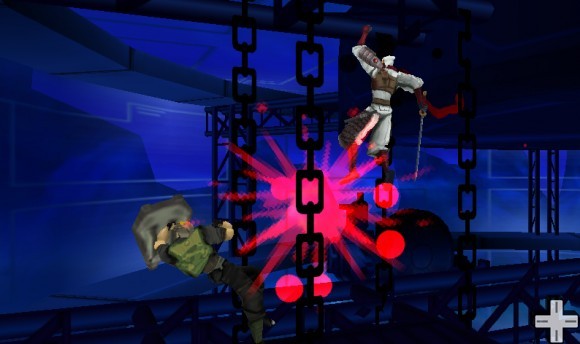
To split the left-to-right levels, there are moments of a sub-boss or horse riding that provides a nice break from killing enemy after baddie after enemy. These use the 3DS’s 3D capabilities and show the game to be what it is – nice to look at. It is no Super Mario 3D Land however when it goes into a 3D scene, it is instantly noticeable. As well as the 3D, StreetPass and Play Coins are used to unlock extra missions and extend the gameplay. More extras can be earned for the skilled who manage to complete the game’s achievement system.
Shinobi is a game for people who want a challenge, that is for sure. It’s hard as nails approach has been the same since it’s first inception in the 1980s. It has stayed true to the arcade roots and has a few flourishes that can only be found on a Nintendo 3DS such as StreetPass missions and the overall look of the title. It does get repetitive and sadly, environments do get stale. For fans this is a must, new comers maybe put off by the samey nature of the game and it’s difficulty.
Need For Speed: The Run

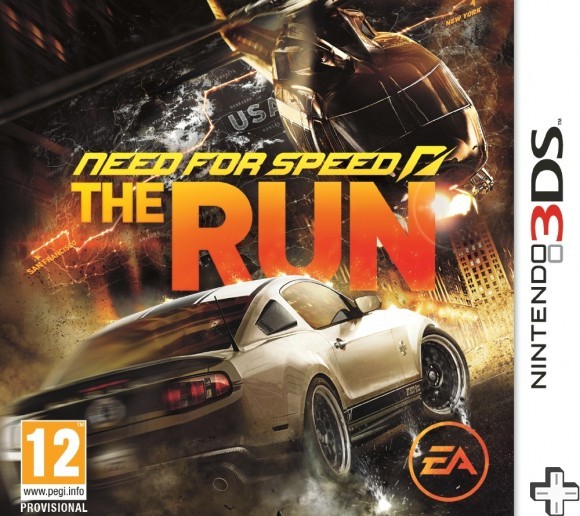
Since its first inception on the original PlayStation in 1994, EA have always tried to set Need For Speed apart from other games in the genre. As well as circuit racing, Need For Speed offered point to point sprints, racing against traffic and trying to escape the police. Fast forward to 2012 and throw in a storyline and a few touchscreen extras and there is the latest instalment, Need For Speed: The Run.
The game has a linear story as ever. The “Run” is a race from San Francisco to New York with a huge pot of cash up for grabs. Using various cars acquired in, shall we say, less honest ways, stock car racer Matt has to get from one end of the country to the other, win The Run and pay off his debts. Think of this as the American Equivalent of the Gumball Rally but with less jokes and more police chases.
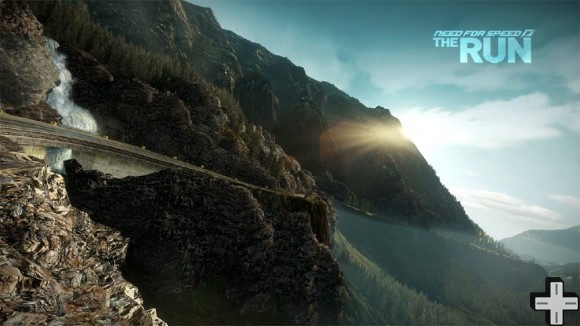
A simple story also stretches to simple gameplay, holding the R shoulder button accelerates and the A button activates the nitro boosts. Occasionally, the game will throw out mini challenges to use the touch screen in certain ways. This annoyingly disrupts the flow of play and the rush for the stylus usually ends with a frustrated player having to restart from the previous checkpoint.
With Need For Speed: The Run’s point-point style each level is roughly the same, having to race up the ranks, avoiding police and traffic as you aim to beat your mysterious rival. Mysterious in the fact his identity is not known so how he is a rival we’ll never know. If you don’t meet the required ranking by the end of the level a restart is required. Its a shame as it takes out the pressure of racing for first place and by the last mission everyone will know the outcome of the game.
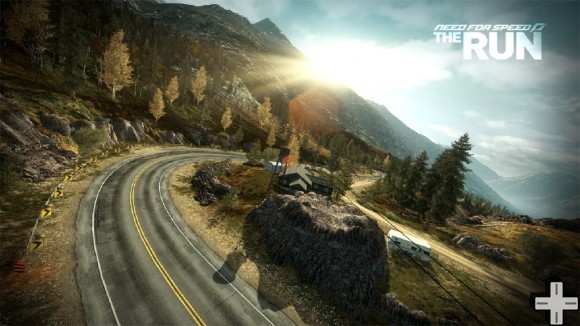
For a console that can produce beautifully crafted images that can be seen in such games as Resident Evil Revelations or Super Mario 3D Land, Need For Speed throws these out of the window and produces something that looks like it has come out of the back end of a PlayStation One. Box style cars resemble a Fiat Cinquecento rather than the Chevrolet Camaro Matt is supposed to be driving.
From the ropey story to the woeful graphics, the saving grace of the game is it’s soundtrack, one thing that the Need For Speed series has always excelled at. From metal to hip-hop and even dubstep, the 3DS is constantly pumping up the tunage to keep adrenaline high. Which is needed as even the wealth of unlockable cars and multiplayer modes can keep Need For Speed being a disappointing game.
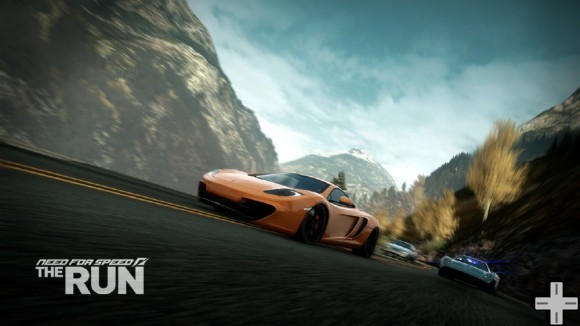
A racing game for the Nintendo 3DS has a lot to live up to – being on a Nintendo console it has stiff competition from Mario and company. It also has to provide an enjoyable 3D experience for games to justify the price of the console and the games. The 3D aspect of Need For Speed: The Run is redundant. There is little to no use implemented and just looks like a blurry mess when racing.
As a driving game about a cross country race in a country that doesn’t believe in cornering Need For Speed is spot on, there is no challenge to the game save from the frustrating “scratch the touchscreen to oblivion in 4 seconds” which crop up at annoying and frankly inconvenient moments. The story should never be taken lightly and in this case shouldn’t be taken at all. It provides a lengthy gap between dreadful and unimaginative “races.” If Need For Speed: The Run was supplied as just a soundtrack, the game would have got perfect marks. It’s the rest of the game that lets it down.
Sonic Generations 3DS

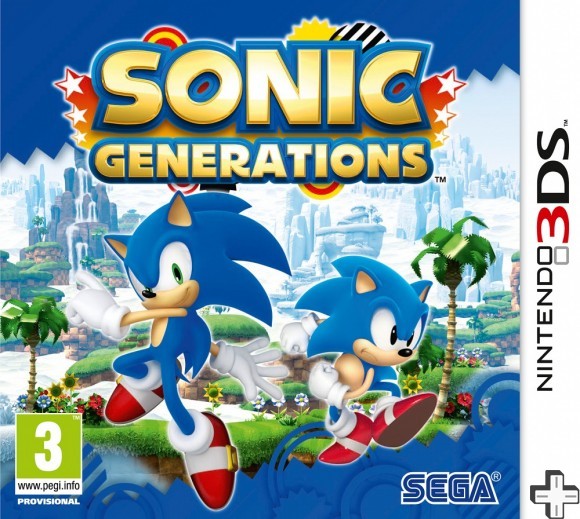
The little blue hedgehog has been with us for the last 20 years and it is fair to say he’s had some ups and some downs. So when SEGA told us that they were producing an almost “best of Sonic” game, the world took notice. Details quickly emerged that this was a marriage of the old school two dimensional Mega Drive Sonic with three dimension Sonic from the noughties and when Sonic Generations was released on the home consoles it proved that the combination of two Sonics could work in almost perfect harmony.
SEGA decided to bring the game to Nintendo’s newest three dimensional console to give gamers who enjoyed the console version to take the two Sonics on the road and from a first glance everything seems eerily similar. Sonic Generations for the 3DS starts off like it’s bigger console counterpart – the Blue Hedgehog’s having a surprise birthday when a mysterious demon shows up and pulls the entire party into a white void. Even the first act of the game is the classic Green Hill Zone complete with retro music and its nostalgic throw back look.
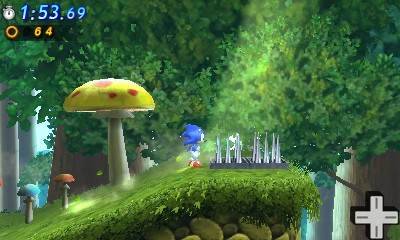
From there however the differences between the home and portable versions appear in droves. There are seven acts, cut from nine. Each has two acts and a special stage to run though. Each stage gives both Sonic’s a chance at playing through it. Young Sonic as he shall hence be known, looks as cute as ever and can perform the spindash, a staple attack from Sonic 2. Granddad Sonic has the typical homing attack and boost moves, enabling him to “grind” on rails.
Blasting through the levels are as easy as ever and will provide little in way of a challenge for anyone who is able to press right and the jump button at the appropriate time. Which is such a shame when it is compared with the levels from the PlayStation & Xbox variations of the game. While the game itself looks great in 3D – especially Mushroom Hill Zone – the game can still be finished in around 4 hours if that.
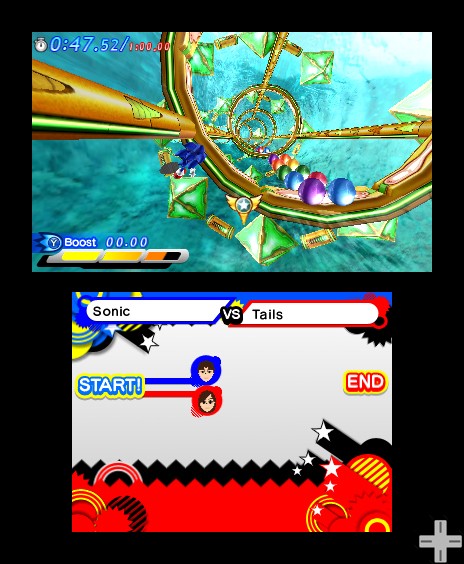
However, such a down point in Sonic Generations, although a big one, is redeemed in how hard it is to actually earn top marks in the Acts. Unlike the PS3/360 versions, where you can still gain an S rank even if you stop half way through a level, have a cup of tea, and have a bath then return to complete the act, on the 3DS effort and skill is required. Which seems pointless considering there are no trophies to be earned from doing so.
There are missions to be unlocked, which sort of replace the trophy aspect and give the game legs, so to speak. 100 missions await, that have varying levels of difficulty and annoyance. One challenge could be so easy it takes three and a half seconds to complete and another take multiple restarts and potentially a new handheld as the temptation to throw the console at a large hard object becomes uncontrollable. Some of these missions will be unlocked naturally as the game progresses with the rest being made up from StreetPassing other Sonic Generations players or using Game Coins.
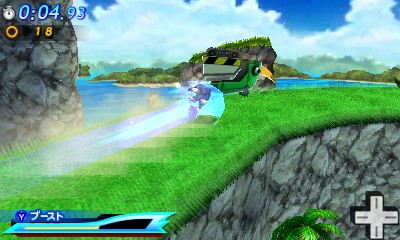
If running missions and trying to get S rankings on all the Acts has you yawning in the face of the fastest blue hedgehog in the world, then SEGA have you catered for too! Online leaderboards challenge every player on every act to either clear it as fast as possible or with the highest score. As well as this, there is a huge amount of extras to unlock, in fact it has just as much than the home console variants.
SEGA has stripped other areas back, replacing the fully animated story down into a manageable cartoon pop up book style animation and toned way down even more on the use of Sonic’s so called friends – in fact only the trusted Tails the two tailed fox, well four tailed foxes in this outing is a serious secondary character in this game. Others just fall by the way side as they are not needed in any way what so ever.
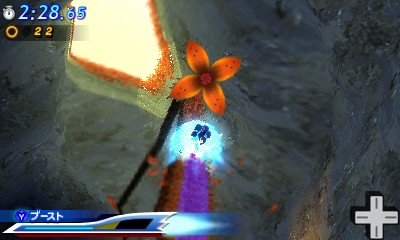
The overall package of Sonic Generations may be condensed to the size of a Nintendo 3DS cartridge, but for all the cut backs in main levels and trophies, SEGA have provided a neat little game that does the legacy of Sonic justice. Yes it’s a little short on the main story mode, but the missions more than make up for this. This is a different experience than the bigger daddy version on the TV screen.
What SEGA did well with the PS3 and Xbox versions in terms of gameplay mechanics is still present. What was created story wise is still the same. But yet, this version of Sonic Generations is more aimed at short bursts of play. Encouraging you to play it on the way to work or school, have it with you for the day and pick up those extra missions when you get home in the evening. It is a far more social game than its bigger brother, and this time you have to actually work hard at the game to finish it and unlock everything.
Super Mario 3D Land

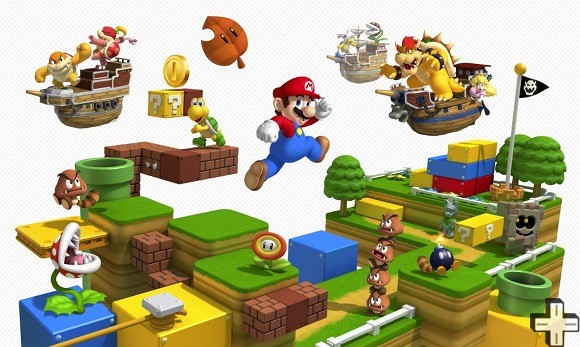
If Mario can be compared to one man it would be Robert De Niro. He has been around for years and is still going strong. The Godfather of acting who takes centre stage when he needs to, and like Mario has starred in some epic titles. Granted, they both share a few turkeys between the two such as Meet The Parents and Mario’s Early Years: Fun With Letters, but for every poor outing, ten classics spring to mind. Raging Bull, Taxi, Super Mario All Stars and who could forget Super Mario 64. Even today, these legends are still relevant with De Niro’s finest acting in Limitless and now we have Mario in his 3D debut. The new kind of 3D that is.
The reason Mario games are looked on so highly is that each one is different but at the same time is pretty much the same game. What Nintendo have done with the moustachio plumber is make noticeable changes to the way the game works but keep the same formula. Almost all games involve Bowser kidnapping Princess Peach and Mario setting off through various worlds to save her (and maybe get that cake she baked for him back in Mario 64).

Not surprisingly Super Mario 3D Land follows the same formula. Mario wakes up one day to check the trees in Princess Peach’s garden and notices the leaves have been blown away. But these are no ordinary oak trees, these are the precious Tanooki trees which give the power of the Tanooki (raccoon) to anything that touches it. A letter is also found from Bowser. Surprise, Surprise, he has Princess Peach and is giving the leaves to many of his minions to help defeat our portly plumber once and for all.
And off Mario runs into the game. The worlds are set out much in a 2D fashion, with a simple yet effective left to right level select. Each of the game’s eight worlds has 5 main stages and a boss castle to contend with, as well as the usual toad houses and new mystery boxes. Much like New Super Mario Bros, the toad houses give away extra lives and items while the new mystery boxes can supply Mario with Star Medals.
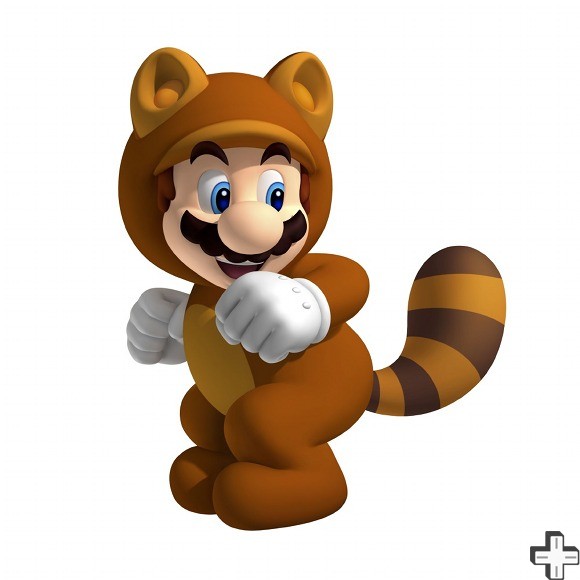
These gold medals are replacements of the big coins seen in the older SNES games and are used to open up certain levels as well as boss levels, which means exploration through the game is key to progression. To help Mario on his way we see the return of a few helpful items but this time, it is a more condensed number than we are used to seeing. The Mushroom and Fire Flower are present as is the propellor box, a slight modification of the mushroom we saw in New Super Mario Bros Wii. The Tanooki suit returns after a long absence. A new addition to the wardrobe is the Boomerang Suit, which as the name implies lets Mario throw boomerangs at enemies. The Bee, Penguin, or Boo suits are dropped in favour of a “less is more” approach, meaning the game relies less on power-ups and more on the gamer’s skill.
By no means does this mean Nintendo won’t help you in times of need. Dying 5 times in a level brings a shiny white Tanooki suit which means Mario won’t get hurt if he is hit by an enemy. Also the Winged “P” box will be used to take players to the end of a level as a last resort if death happens 10 times in a row. While Mario is running around the levels in his cute Raccoon suit, it is hard not to notice how well the levels are designed. Levels vary in length and as the game progresses, they seem to get harder. Most players will get through the majority of levels with ease but a few can get irritating. This is good because Nintendo do not want you thinking that the game is a walk in the park!
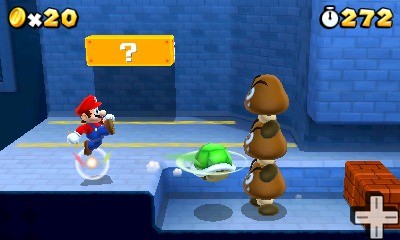
Bright and vibrant colours fill the screen, and the key feature – the 3D – is used fantastically, in fact players have the option of the standard 3D view and by flicking the down button on the D-pad, it can be changed to give a better perception of depth for those tricky jumps. Of course the game works with 3D turned off but if this is done so, the game doesn’t seem to work. In 2D, the levels are made confusing and it is tough to judge how much pressure to put on a jump or where to aim for to land. As with the visuals, Nintendo have worked their magic on the music and the usual Mario tunes are all present, mainly a modern twist on the old SNES music but it still has you humming along while playing or walking down the street doop-wooping the menu song.
While you are whistling down the street, this brings a function that is slowly being implemented more and more with the 3DS. StreetPass is used to unlock extra bonus levels to play through. These give the opportunities to play for more star coins or just enjoy the game that little bit longer. Once a pass has been made, icons on the map will show where Mario needs to go in order for him to pick up these items.
As with other recent titles, Mario has returned to his 2D roots and have a simple world select rather than a larger hub for exploration. This time however, Nintendo have scaled the selects way back and leave us with a simple system of pressing right for the next level. It feels like all of the design was thrown into the level design and presentation suffered as a result. A level select that looked like New Super Mario Bros would have been an ideal fit for Mario’s first 3DS outing.
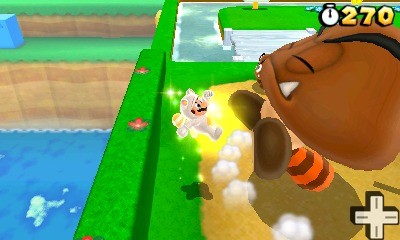
However, with this aside it is once again hard to fault a Mario game. The levels are fantastic in their designs and difficulties, the collection of Star Medals means a degree of exploration is needed to progress through the game, and unlockables and StreetPass keep extend the lifespan of the game. It has been a long wait for Mario to make his mark on the Nintendo 3DS but Super Mario 3D Land is worth the wait. It is one of the most original and enjoyable titles on the console and up their as one of the best Mario outings. Every 3DS owner should have this title in their collection.
Captain America: Super Soldier 3DS

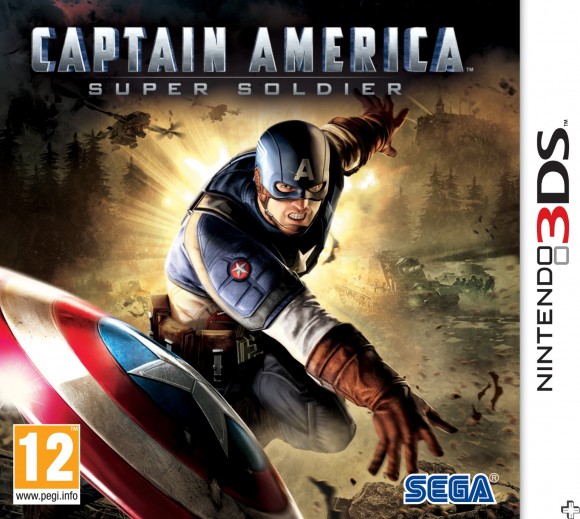
Captain America is an all American hero fighting in the battlefields of World War Two. Reading the comics, watching the movies or even resorting to Wikipedia will tell you that the Cap is the Marvel equivalent of Superman. This one man wrecking machine is on a mission to save Prisoners of War and defeat the evil HYDRA unit, a group headed by the maniacal Red Skull. A man so diabolical he makes Hitler look like one of the Care Bears.
Like Thor before it, SEGA have taken their time to create a 3D version of Captain America for the Nintendo 3DS. However in taking an extra 6 months to deliver something of an improvement, what is presented to us is a condensed version of the somewhat disappointing Wii incarnation. A few changes have had to be made of course, the camera has been freed somewhat, appearing to be less fixed on the Captain’s behind.
The camera, although less rigid is still “stuck” behind the Captain’s backside which makes exploring a pain. Not that backtracking or exploration is something that will be happening on a regular basis. The game has a very liner approach, with each mission progressing through the castle peice by peice. The extras such as Finding POWs, disabling bombs and the “hidden” challenges are always on the path of the level and require little exploration, and the reward for completing each of the challenges is always some form of artwork.
The hidden Zemo challenges highlight another big problem with Captain America. They revolve around breaking as many targets as possible in a specific time by using the primary weapon – the shield. The targeting system has been moved clumsily from pointing at the screen with the Wii Remote, and placed into the 3DS’s touchscreen. Because of the camera issues, to target anything at all is a clunky and time consuming practise that is just infuriating when under pressure from a countdown clock.
Targeting problems aren’t the only thing our American Captain has to worry about, he may well be a Super Soldier, but he isn’t half slow when scrapping with the Nazis. With a fight system based on the brilliant Batman: Arkham Asylum, the idea is to bash one button and counter when prompted. However where this comes unstuck is that Batman is tight and responsive in his movements. Captain America is slow on the uptake which results in a punch to the head to the character.
A punch to the face doesn’t solve the Captain’s woes either. The environments are an offence to the eyes. Just like in the Wii version, everything is a colourful shade of grey. Running around a castle one would expect colourful paintings, beautiful murals hanging from walls, or even a lush carpet or two. Nothing of the sort in this game. The walls are bland and lifeless and the castle is just filled with the odd chair or vase and enough scaffolding so that Jackie Chan can fight off 100s of baddies.
From the Wii to the 3DS, Captain America: Super Soldier seems to have worse graphics than was ever thought possible. Even the original Nintendo DS would have no problems pulling off the graphics. The 3D is non existent in the game. It makes no difference having the slider up or down which begs the question: where were the 6 months between the Wii and the 3DS versions spent?
With Thor, SEGA refined, developed and created a better game for the Nintendo 3DS than the console counter parts. Annoyingly, Captain America: Super Soldier isn’t the same story. It feels OK to play but ultimately it’s the console version we played 6 months ago. There are some saving graces, it is much harder to progress than the Wii version and the voice acting isn’t half bad. Time was needed on the targeting system, graphics and speeding up the Captain so he doesn’t get hammered in battles for no reason. As it stands, only the hardcore fans of Captain America will enjoy this outing as it remains mediocre, at best.
Thor: God Of Thunder 3DS


Like the rising of the moon, it is inevitable that video game developers will try and cash in on the next biggest movie blockbuster. The year so far has spawned games such as Thor, Captain America, The Green Lantern and the list goes on. Most are lack-lustre and are missing the element of time it has taken the movie producer to create a genius work of art. SEGA have been at it again with the latest effort – Thor: God Of Thunder. Hold on, this seems a little familiar.
In some what of a brilliant tactic, SEGA have timed the Nintendo 3DS version of Thor to be released in line with the Blu-Ray release of the Marvel picture. This gave the developers – Red Fly Studios an extra six months to make a handheld game that people would choose over the home console versions. But was the extra time that was given used in such a game that left an impression more than the average console version?

Thor: God Of Thunder 3DS certainly makes an impression right from the moment the cartridge enters the system. Unfortunately, it is not the best start to the proceedings. After pressing the A button to bring up the start menu, tapping the bottom screen to choose a profile is a problem. As far as navigating the menus are concerned, the touchscreen is redundant. After nearly 8 years of playing Nintendo DS this is a feature most will have gotten used to. Surprisingly its hard to get used to!
After this small oversight, the game starts with a two dimensional cinematic sequence outlines the plot for the game. Using the same story as God Of Thunder on the Xbox 360: the war to save Asgard has begun and it is up to Thor, to make sure it does not fall. To do so, the Norsk God must battle his way through hoards of enemies using Mjölnir – his big hammer. Although only played in two dimensions, the game starts by throwing Thor head first into battle.

Guiding Thor through the relentless enemies of Asgard is simple enough as the camera is behind the God himself. This eliminates the shoddy camera issues experienced on the console version and with the camera following Thor through the world, the 3D effects never blur and remain consistent. When fighting in big open spaces however, the camera is an issue due to the fact it does not pull back to view the entire area. This means that enemies are often off screen and it is hard to judge how many are left.
Camera improvements aren’t the only thing that SEGA have added to the game. The last six months have seen the battle system heavily overhauled. This time, its not just a case of bashing the same button to defeat the bad guys. The use of two buttons is implemented: one for quick and light attacks, the other is for slower heavy attacks. Providing more of a challenge, it takes longer to break and shatter the pesky ice demons that litter Asgard. They have also brought purpose to the multiplier that is earned by killing the beasts.
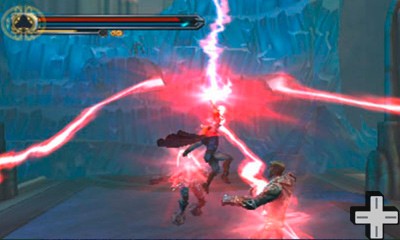
Special power-ups are picked up during the game are given extra power if multiplier combo reaches a high enough level. Activated by the touchscreen, and depending on which one used will have a different effect – usually resulting in more power for Thor and more pain for the enemies on the wrong side of the hammer. Valour points are once again used to give Thor his abilities and are gained either by killing large enemies or smashing the environments.
For the Nintendo 3DS, Thor: God Of Thunder looks like a condensed Wii version. Character models are defined, distinguishable and smooth running, however they do not interact well with the surroundings. Too many times has Thor jumped through ledges when trying to climb on them or appeared to be floating above the ground. The 3D in the main game is effective throughout with the exception of the cutscenes where it is missed completely. The sound in the game is not a problem at all. The addition of full voice acting from the stars of the film is a welcome addition and is used as a perfect narration to direct the story.

Thor: God Of Thunder 3DS is much like the console version in terms of plot lines and it’s graphical style. Camera fixes and a hugely improved combat system make the game a slicker version of what was seen only six months ago. Niggles such as not using the touchscreen in menus and the lack of 3D cutscenes is a step back for a console that has two main selling points – a touchscreen and the ability to produce 3D.
The charm of the game can be seen in the character himself, by his very appearance when people see Thor, they know exactly what to expect – no masquerade, no hidden depths just a blonde haired brute with a gigantic hammer and a cape. It is in no way perfect, but it is an improvement on what we saw six months ago. The game still gets repetitive and and some points frustrating due to enemies attacking off screen, however what Thor has against it is slightly outweighed by positive aspects that have been improved on.
The Legend Of Zelda: Ocarina Of Time 3D

The Ocarina of Time has been with us since 1998 and it has been widely praised by every single critic in the business – it was even the first game to obtain Famitsu’s perfect score! Since the N64 days, the game has been re-released on each Nintendo home console with no real changes, except for the frame rate speed increase to 60hz with the GameCube version. Keen to show off what can be done with the 3DS in terms of three dimensional visuals and processing power, Nintendo have cleverly thought to remake one of the most acclaimed games in the world, which in turn would drive sales of the 3DS. The question that has to be asked is – should people pay for a fourth copy of a game most people have played to death?
The answer simply is yes. From the moment the cartridge enters the console and the Hylian Shield, Master Sword and one annoying Fairy pop up in 3D, a feeling of familiarity and warmth will fill the heart of the gamer who first played the title in ’98. For the newies to the game or even the series itself will later realise that the game isn’t just a nostalgic trip down memory lane. Which ever way people look at this game – it is something special.
The Legend of Zelda: Ocarina of Time tells the tail of Link – a Forest Child – who is sent on a quest to save the land of Hyrule and rescue the Princess Zelda. To do so he must embark on the quest of a lifetime, overcoming huge dungeons, defeating powerful enemies and even travelling through time itself to stop the evil Gannondorf. This classic tale of good vs evil will have Link gaining powers and collecting weapons he never thought possible.
Grezzo, a small Japanese developer,was given the mammoth task of revamping the game and have done a superb job, and it really feels like it was made in the 21st century. Back in the day, The Legend of Zelda: Ocarina of Time pushed the limits of what the N64 could produce graphically. Today Ocarina of Time is once again pushing at the boundaries of what the Nintendo 3DS can produce, with changes to the basic visual theme, like the shops being fully stocked, each house looks unique and the epic backgrounds no longer have the “pasted on” look. The 3D has been dealt with perfectly, giving the game a great sense of depth perception that especially shines through when jumping between platforms, horse riding or playing the diving game in Zora’s Domain. There is an attention to detail that developers of the newest of games will miss. It is brilliant to see things like The Great Deku Tree, who’s new tash Tom Selleck would be proud of, or riding Epona through the expansive Hyrule Field for the first time.
Cleverly, Grezzo have preserved the original sounds such as the ever irritating “Hey! Listen!” from Navi. All of the music scores from the N64 have been lovingly recreated on the little handheld console. Walking into the Lost Woods will still bring a smile, and the Shadow temple is still as eerie as it was back in 1998. Even though the music is 13 years old it is still fresh and even better than some of today’s counterparts.
This is not just a facelift, a game made younger and more up-to-date by adding all new graphics Nintendo have also added the Master Quest, which is accessible only after the first game has been beaten. More enemies and changed dungeon layouts means that even the most verteran players face a challenge when playing Master Quest. This is coupled with the boss challenge mode, and as the name suggests lets Link revisit a defeated boss and beat them again, this time though it is a timed battle.
The Legend of Zelda: Ocarina Of Time 3D does have a few niggles, however thankfully they are minor. The control system can have a few moments where Link can get caught between the camera readjusting and the circle pad. Also learning the songs on the Ocarina isn’t as memorable as it once was. This is down to the 3DS having a slightly different button layout to an N64 controller but one feels the notes could have been arranged in a better order.
Finally and possibly the most disappointing fall down for the game is that it now features more in depth hints than ever before. On the sub-quests an arrow is now placed on the world map telling Link where to head. Sheikah Stones provide visual hints of where to go to progress in the story, which goes to prove that video games are getting easier. The inclusion of this new feature, whilst helpful for new gamers, only goes to reinforce the mantra that games are getting easier. After all, it wasn’t needed in 1998. Surely without them it would stretch a £40 game further and make more of a challenge!
Ocarina of Time 3D is still a brilliant game which ever way it is looked at. For veterans of the game, it reignites the charm and passion it brought all those years ago. It will still test players to complete the game as fast as possible and challenge them to remember where every collectable is hidden. For new gamers, expect a challenging and epic game lasting a minimum of 50 hours game time. Factor in collecting all items, hearts and Skulltula tokens will take this to a mammoth 100 hours easily. With a few niggles such as the famous bug glitch being rectified, The Legend of Zelda: Ocarina of Time still pushes for gaming perfection just as it did in 1998. It maybe a remake but it is more enjoyable than some brand new titles on the market today.


